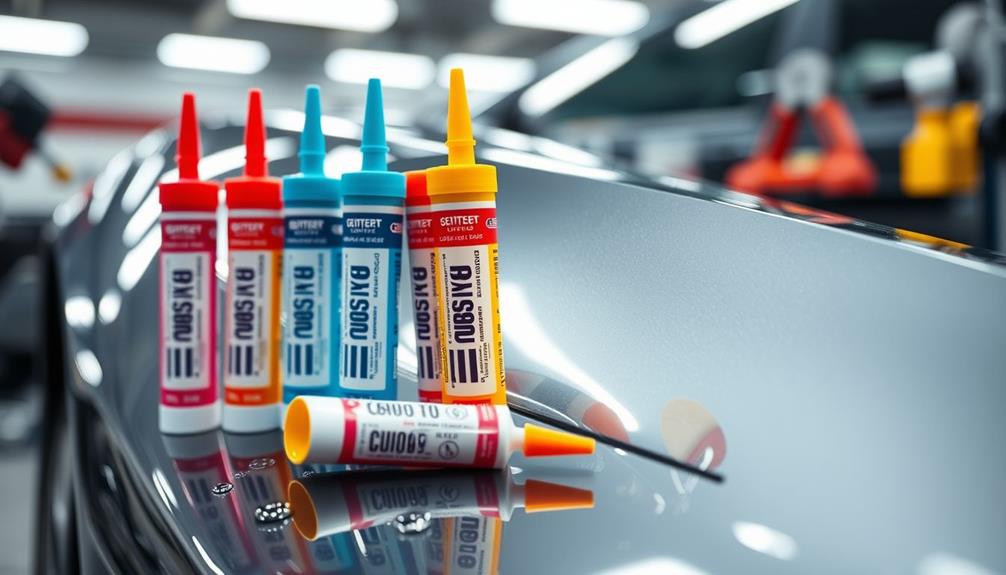I've discovered 15 automotive sealants that promise a durable, leak-free finish for your vehicle. Among them, Permatex 81158 Black Silicone Adhesive stands out for its flexibility and temperature resilience. The quick-setting Sika Sikaflex-221 is fantastic for various surfaces, while the 3M Urethane Seam Sealer is perfect for filling voids securely. If you're looking for something waterproof, the XFasten Silicone Sealant is impressive, lasting up to 15 years. Each sealant offers unique benefits, making them suitable for different applications. Stick around, and I'll share more options and tips for selecting the perfect sealant for your needs. When it comes to filling larger gaps or repairing body panels, it’s important to also consider the best body fillers. Bondo Professional Gold Filler is known for its easy application and superior adhesion, making it a top choice for many automotive enthusiasts. Another popular option is the 3M Bondo Ultimate, which is formulated to be non-shrinking and easy to sand, providing a smooth and seamless finish. When choosing a sealant or body filler, it’s essential to consider the specific needs of your vehicle and the type of repair or application you are working on.
Key Takeaways
- Automotive sealants prevent leaks and enhance durability, ensuring vehicle performance and safety in various conditions.
- Key features include high durability, waterproofing, chemical resistance, and strong adhesion to multiple surfaces.
- Temperature resistance ranges from -75°F to 500°F, crucial for preventing failures in automotive systems.
- Quick-curing formulations minimize downtime, allowing for efficient project completion and immediate use.
- Various types, such as RTV silicone, polyurethane, and specialty sealants, cater to specific automotive needs and applications.
Permatex 81158 Black Silicone Adhesive Sealant, 3 oz. Tube, Pack of 1
If you're looking for a reliable sealant that can handle both indoor and outdoor applications, the Permatex 81158 Black Silicone Adhesive Sealant is an excellent choice. This versatile 3 oz. tube contains a professional formula that's sensor-safe and ideal for a variety of materials like glass, metal, and plastics. I love that it's waterproof and flexible, capable of withstanding temperatures from -75°F to 450°F. Whether I'm sealing door frames, fixing weather trim, or mending leaks on my vehicle, it performs exceptionally well in heavy rain and storms. Just be sure to wear gloves when applying, as it can get a bit sticky. Cleanup is straightforward, especially with wet rags handy. Overall, it's a high-quality adhesive for automotive needs.
Best For: Individuals seeking a versatile and durable sealant for both indoor and outdoor applications, particularly in automotive and home repair projects.
Pros:
- Waterproof and flexible, making it suitable for various environmental conditions.
- High-temperature resistance from -75°F to 450°F, ensuring reliability in extreme situations.
- Strong adhesion that effectively seals and repairs multiple materials including glass, metal, and plastics.
Cons:
- Application can be sticky, requiring gloves for easier handling.
- Some users report difficulty in squeezing the tube, which may affect application ease.
- Not suitable for engine gasket applications, limiting its use in certain automotive repairs.
Permatex 80050 Clear RTV Silicone Adhesive Sealant, 3 oz
Permatex 80050 Clear RTV Silicone Adhesive Sealant is an excellent choice for DIY enthusiasts and professionals alike who need a dependable adhesive for a variety of projects. This professional-grade sealant is sensor-safe and works indoors and outdoors, making it incredibly versatile. I love that it's waterproof, flexible, and resistant to weather and grease, operating effectively in temperatures from -75°F to 400°F. I've found it perfect for sealing everything from door frames to kitchen sink repairs. Users rave about its quick drying time and clean finish, although the tube cap could be sturdier. Overall, I highly recommend Permatex 80050 for its strong bonding capabilities and excellent value, whether for personal use or professional applications.
Best For: DIY enthusiasts and professionals seeking a reliable adhesive for various indoor and outdoor projects.
Pros:
- Versatile: Suitable for bonding and sealing a wide range of materials, including glass, metal, and ceramics.
- Quick Drying: Users appreciate the fast drying time, allowing for efficient project completion.
- Waterproof and Flexible: Effective in various weather conditions and maintains flexibility after curing.
Cons:
- Tube Cap Quality: Some users report that the caps are thin and prone to cracking.
- Not for Engine Gaskets: Limited application in certain automotive uses, specifically engine gaskets and windshield installations.
- Excess Cleanup: While excess can be wiped away, some users may find it messy if not careful during application.
J-B Weld 31319 Black RTV Silicone Sealant and Adhesive – 3 oz.
The J-B Weld 31319 Black RTV Silicone Sealant and Adhesive is an excellent choice for anyone tackling automotive repairs or household projects that require a reliable seal. This general-purpose RTV silicone comes in a convenient 3 oz. tube and is made in the USA. I appreciate its durability, as it forms a tough, waterproof seal that resists shrinking, cracking, and weathering. Its versatility allows me to use it for bonding, sealing, and even weather stripping in various applications. The easy-to-use nozzle lets me apply it precisely, and cleanup is a breeze. With a drying time of just an hour, I can quickly tighten connections and get back to work. Overall, it's a fantastic addition to any toolkit!
Best For: Those looking for a reliable and versatile sealant for automotive repairs and household projects.
Pros:
- Durable seal that is waterproof and resistant to shrinking, cracking, and weathering.
- Versatile application suitable for various uses such as bonding, sealing, and weather stripping.
- Easy to apply with a precision nozzle and straightforward cleanup.
Cons:
- Requires roughening of surfaces for optimal adhesion, which may not be convenient for all users.
- Full cure time of 24 hours may delay project completion.
- Limited size options, as it only comes in a 3 oz. tube, which might not be sufficient for larger jobs.
3M Dynatron Auto Seam Sealer Caulk (12 oz, Grey Color)

For anyone tackling autobody repairs, the 3M Dynatron Auto Seam Sealer Caulk (12 oz, Grey Color) stands out with its permanently elastic formulation, ensuring a reliable seal that remains flexible over time. I appreciate how easy it is to apply; it's brushable and paintable, making it perfect for various surfaces like bare metal and painted areas. With a quick handling time of just 10-20 minutes and a full cure time of 24 hours, it fits well into any repair schedule. Plus, it's waterproof and non-staining, so I don't have to worry about drips or sagging. With a solid rating of 4.6 out of 5 stars, it's no surprise that many users rave about its effectiveness in sealing weld seams and preventing leaks.
Best For: Automotive professionals and DIY enthusiasts looking for a reliable seam sealer for autobody repairs.
Pros:
- High adhesion to various surfaces ensures effective sealing.
- Quick handling time and waterproof formulation for efficient repairs.
- Brushable and paintable, allowing for seamless integration with existing finishes.
Cons:
- Not available for consumer sale, limiting access for general users.
- Requires a full 24 hours to cure, which may delay project completion.
- May be too specialized for non-automotive applications.
Polyurethane Seam Sealer Automotive Compound Kit

Seeking a reliable solution for automotive repairs? The Polyurethane Seam Sealer Automotive Compound Kit is an excellent choice. It's a durable and flexible auto body filler that works on bare, primed, or painted surfaces, making it perfect for both automotive and RV applications. I love its superior adhesion on various metal surfaces, plus it's non-shrinking and low-odor. It permanently fills gaps, preventing leaks and promoting corrosion resistance. You can apply it with a standard caulking gun, and it cures quickly—allowing for priming and painting in just 24 hours. Users appreciate its ease of use and great adhesion, making it ideal for rust repairs and body panel applications. Trust me; this kit is worth considering for your next project!
Best For: Automotive enthusiasts and professionals looking for a versatile seam sealer for rust repairs and body panel applications.
Pros:
- Durable and flexible formulation suitable for various surfaces.
- Quick-curing allows for priming and painting in just 24 hours.
- User-friendly application with standard caulking guns and low-odor formula.
Cons:
- Some concerns regarding long-term durability reported by users.
- Requires thorough surface preparation for optimal adhesion.
- Curing time of 45 minutes may delay immediate use in some applications.
Sika Sikaflex-221 Multi-Purpose Polyurethane Sealant/Acrylic Adhesive

Looking for a reliable sealant that can tackle diverse projects? I've found the Sika Sikaflex-221 Multi-Purpose Polyurethane Sealant to be an excellent choice. This black sealant not only creates a permanent elastic seal but is also sandable and paintable, making it versatile for various applications. It bonds well to metals, plastics, wood, and ceramic materials, and cures quickly when exposed to moisture.
What impresses me most is its durability; it resists seawater, diluted acids, and even caustic solutions. Plus, it's waterproof and stain-resistant, perfect for long-lasting use. With NSF approval for safe application in drinking water systems, I feel confident using it in my projects. Users rave about its strong adhesion and low odor, too!
Best For: DIY enthusiasts and professionals looking for a versatile, durable sealant for various materials and applications.
Pros:
- Strong adhesion to multiple substrates including metals, plastics, and wood.
- Quick curing time upon exposure to moisture, enhancing project efficiency.
- NSF approved for use in drinking water systems, ensuring safety in sensitive applications.
Cons:
- Requires moisture for curing, which may not be ideal in very dry environments.
- Limited color options available, as it primarily comes in black.
- Initial odor may be present during application, although it is low compared to other sealants.
Polyurethane Windshield Adhesive with Fast Curing Formula

With its high bond strength and fast curing formula, the Polyurethane Windshield Adhesive is ideal for automotive professionals and DIY enthusiasts alike who demand reliable performance. I've found its medium viscosity makes application easy, fitting perfectly in standard caulking guns. The non-sag properties provide excellent control, which is essential when working on various auto glass projects, from windshields to sidelights.
To use it, I detach wipers, remove old glass, and clean surfaces thoroughly. After aligning the new glass, I apply the adhesive and press it into place. It cures rapidly, offering weather-resistant protection. With an impressive 4.5-star rating from customers, it's a go-to choice for those seeking durability and efficiency in their automotive projects.
Best For: Automotive professionals and DIY enthusiasts seeking a reliable, high-strength adhesive for various auto glass applications.
Pros:
- Strong adhesion provides a durable bond for automotive glass.
- Easy application with medium viscosity that fits standard caulking guns.
- Rapid curing offers quick weather-resistant protection.
Cons:
- Potential messiness during application may require extra cleanup.
- Temperature sensitivity could affect performance outside the recommended range.
- Requires preparation such as cleaning and aligning surfaces before use.
Polyurethane Seam Sealer Automotive Compound Kit (2 Pack)

If you're tackling automotive repairs, the Polyurethane Seam Sealer Automotive Compound Kit (2 Pack) is an exceptional choice for ensuring durable and flexible seals on both bare and painted surfaces. This kit stands out with its superior adhesion, making it ideal for various applications, whether you're working on door panels or wheel wells. I appreciate the non-shrinking, low-odor formula, which cures quickly—just 45 minutes to settle and ready for priming in 24 hours. Plus, it holds up well under high heat and humidity, ensuring long-lasting results. The included nitrile gloves and application tip make the process seamless. Users rave about its effectiveness, and I found it to be a cost-effective option compared to other brands.
Best For: Automotive enthusiasts and professionals looking for a reliable seam sealer for various repair projects on both bare and painted surfaces.
Pros:
- Durable and flexible formulation suitable for a variety of automotive applications.
- Quick curing time, allowing for efficient project completion and priming within 24 hours.
- Cost-effective option compared to competitor products, offering excellent value without compromising performance.
Cons:
- Requires proper surface preparation for optimal adhesion, which may be time-consuming.
- The low-odor formula may still have some chemical scent that can be bothersome to sensitive users.
- Not suitable for use in locations with extreme moisture exposure before complete curing.
3M Urethane Seam Sealer (08367)

For anyone tackling automotive repairs, the 3M Urethane Seam Sealer (08367) stands out as a reliable choice due to its permanently flexible nature. This product boasts a single-component formula that adheres excellently to bare metal, primed surfaces, and painted areas. I love how it cures quickly, becoming water-tight in under an hour, making it perfect for urgent fixes. Its thick consistency fills large voids seamlessly, and I can paint over it in just 30-45 minutes. Users rave about its effectiveness in sealing seams and preventing leaks, which gives me confidence in my repairs. While some might find the price a bit higher than competitors, the quality and reliability of 3M products make it worth every penny.
Best For: Automotive enthusiasts and DIYers seeking a reliable sealant for repairs and seam sealing.
Pros:
- Quick curing time: Becomes water-tight in less than an hour, ideal for urgent repairs.
- Permanently flexible: Maintains flexibility and durability, preventing cracking or shrinking.
- Easy application: Thick consistency allows for effective filling of large voids and smooth feathered edges.
Cons:
- Higher price point: Some users may find it more expensive than competing products.
- Smaller tube size: The 310 mL cartridge may be less economical for larger projects.
- Variable drying times: A few users experienced longer drying times than advertised.
Permatex Ultra Black RTV Silicone Gasket Maker (3 oz)
Permatex Ultra Black RTV Silicone Gasket Maker (3 oz) stands out as the ideal choice for automotive enthusiasts and professionals alike, thanks to its exceptional oil resistance and flexibility. This fast-curing, sensor-safe formula can withstand temperatures from -65°F to 500°F, making it perfect for various applications like valve covers and oil pans. I've found its superior adhesion to oily surfaces impressive, as it resists aging and thermal cycling without hardening. Users often report no leaks after application, which speaks volumes about its reliability. For best results, I recommend cleaning surfaces thoroughly and applying a uniform bead. Allow it to cure overnight for peak performance. If you're looking for a durable and effective gasket maker, this product is a must-try!
Best For: Automotive enthusiasts and professionals seeking a reliable, high-performance gasket maker for various applications.
Pros:
- Superior oil resistance ensures long-lasting seals in high-stress environments.
- Fast-curing and sensor-safe formula allows for quick and easy application.
- Versatile use for multiple automotive applications, including valve covers and oil pans.
Cons:
- Requires thorough surface cleaning before application for optimal results.
- Curing time may vary, so planning ahead is necessary to avoid delays.
- Not suitable for all types of surfaces, may not adhere well to some plastics or rubber.
Butyl Sealant Tape for Automotive Sealing

Whether you're a DIY enthusiast or a professional mechanic, Butyl Sealant Tape is an essential tool for automotive sealing. This versatile tape, made of butyl rubber, measures 13 feet and is perfect for sealing applications in cars, RVs, and even boats. Its non-drying, flexible nature makes it easy to install, and it provides excellent waterproofing and sound insulation. Before you apply it, just clean the area and refrigerate the tape for 30 minutes to make removal of the paper backing easier. I've found that letting the sealant sit in the sun helps it become tacky, ensuring a strong bond. Users rave about its effectiveness, especially in older vehicles, making it a reliable choice for anyone looking to prevent leaks.
Best For: DIY enthusiasts and professional mechanics seeking a reliable sealing solution for automotive and marine applications.
Pros:
- Easy to install with flexible, non-drying characteristics.
- Excellent waterproofing and sound insulation properties.
- Highly effective for sealing leaks, especially in older vehicles.
Cons:
- Residual mastic can be messy if not handled carefully.
- Requires proper area cleaning and pre-application refrigeration for optimal results.
- Limited to sealing applications; may not suit all repair needs.
Permatex 59235 High Temperature Thread Sealant, 50 ml Tube , White

If you often tackle automotive repairs that involve high-pressure and high-temperature components, you'll find the Permatex 59235 High Temperature Thread Sealant to be an excellent choice. This 50 ml tube of white sealant locks and seals threaded fittings, effectively resisting leakage and vibration loosening. It handles a temperature range from -65°F to 400°F, making it perfect for head bolts, oil and coolant lines, and fuel fittings. I appreciate that it lubricates threads for easy assembly and disassembly, and you can reposition parts up to four hours after application. With a stellar rating of 4.7 out of 5 from nearly 3,000 users, it's proven to seal engine components successfully, ensuring no leaks after use.
Best For: Automotive enthusiasts and professionals who need a reliable sealant for high-pressure and high-temperature applications.
Pros:
- Locks and seals threaded fittings effectively, preventing leaks and vibration loosening.
- Wide temperature range (-65°F to 400°F) suitable for various automotive components.
- Repositionable up to four hours after application, allowing for adjustments during assembly.
Cons:
- Curing time can take up to 72 hours without an activator, which may delay projects.
- Smaller tube size may not be sufficient for larger jobs, leading to potential multiple purchases.
- Limited to threaded fittings, which may not meet the needs of all sealing applications.
XFasten Silicone Sealant Waterproof Black Cartridge
The XFasten Silicone Sealant Waterproof Black Cartridge is an excellent choice for DIY enthusiasts and professionals alike who need reliable sealing solutions for their automotive projects. This industrial-grade sealant offers impressive durability, protecting against water damage and leaks for up to 15 years. I've found it particularly effective for sealing windows, doors, and even RVs. The application is straightforward thanks to its high-pressure resistant cartridge and jam-resistant nozzle. It sets quickly—30 minutes for minor repairs—making it a convenient option. However, I've noticed that larger projects might require a full 24 hours to cure. While most users rave about its adhesion and flexibility, a few reported it can be sticky during application. Overall, it's a solid choice for reliable sealing.
Best For: DIY enthusiasts and professionals seeking a durable, weatherproof sealant for automotive and general use projects.
Pros:
- Excellent adhesion and flexibility, providing reliable sealing for a variety of applications.
- Quick setting time of 30 minutes for minor repairs, making it convenient for urgent tasks.
- Rated to protect against water damage and leaks for up to 15 years, ensuring long-lasting performance.
Cons:
- Larger applications may require up to 24 hours to fully cure, which can be inconvenient.
- Some users report the sealant can be sticky during application, potentially complicating use.
- A few reviews suggest it may not be suitable for specific automotive applications, limiting its versatility.
Permatex 80062 High Tack Gasket Sealant, 4 oz.

For anyone tackling automotive repairs, the Permatex 80062 High Tack Gasket Sealant, with its fast-drying, all-purpose formula, is a game changer. This sealant has a tacky paste consistency that dries to a non-brittle film, remaining tacky indefinitely, which makes it perfect for holding gaskets in place during assembly. I love how versatile it is—compatible with rubber, cork, paper, and metal, and it withstands temperatures from -65°F to 500°F. Plus, it's resistant to various chemicals like gasoline and oil, making it ideal for valve covers and fuel pumps. The included brush applicator simplifies application, and many users, including myself, appreciate that it's easier to clean up than traditional RTV silicone. It's truly a reliable choice for leak prevention!
Best For: Automotive enthusiasts and professionals looking for an effective gasket sealant that holds gaskets in place during assembly.
Pros:
- Versatile compatibility with rubber, cork, paper, and metal gaskets.
- Fast-drying formula that remains tacky indefinitely for easy re-servicing.
- Resistant to various chemicals including gasoline and oil, ensuring reliability in automotive applications.
Cons:
- Tackiness may create mess if not managed carefully during application.
- No specific cure time mentioned, which might concern some users about drying reliability.
- Limited weight (0.01 ounces) may suggest less product for extensive projects.
Loctite PST 592 Thread Sealant for Automotive

Loctite PST 592 Thread Sealant stands out as an excellent choice for automotive enthusiasts and professionals seeking reliable sealing solutions. This high-viscosity, opaque, off-white sealant is specifically designed for low-pressure applications, making it perfect for automotive uses like fuel, oil, and coolant lines. I particularly appreciate its ability to resist leakage in threaded metal fittings up to 400°F, ensuring durability under tough conditions.
What I find most impressive is its immediate low-pressure sealing capability, allowing adjustments within 24 hours after application. Plus, it prevents galling on pipe threads and fittings, which is a game-changer. Users consistently report high satisfaction, especially when sealing components like carburetors and oil drain tubes. Overall, it's a reliable choice for effective sealing in various applications.
Best For: Automotive enthusiasts and professionals seeking a reliable thread sealing solution for low-pressure applications.
Pros:
- Prevents leakage in threaded metal fittings up to 400°F, ensuring durability.
- Immediate low-pressure sealing allows for repositioning within 24 hours after application.
- Lubricates threads for easy assembly and disassembly, enhancing user experience.
Cons:
- Not suitable for plastic piping, limiting its application range.
- May require longer curing times for full sealing against pipe burst pressure.
- High-viscosity may be challenging to apply in tight spaces compared to other sealants.
Factors to Consider When Choosing Automotive Sealant

When choosing the right automotive sealant, I always consider several key factors. It's essential to examine temperature resistance, material compatibility, and adhesion strength to guarantee the sealant performs well in different conditions. Plus, I look at the application method and cure time to make certain it fits my project needs.
Temperature Resistance Guidelines
Understanding temperature resistance is fundamental in selecting the right automotive sealant for your needs. Automotive sealants typically function within a temperature range of -75°F to 500°F, but this can vary depending on the specific type of sealant you choose. If you're working on engine components or exhaust systems, you'll want to take into account high-temperature sealants that can handle intermittent temperatures up to 500°F.
On the other hand, if you live in a colder climate, low-temperature flexibility is essential. You need a sealant that remains effective and doesn't become brittle at temperatures as low as -75°F. For high-performance applications, look for sealants designed to resist thermal cycling, which is the repeated heating and cooling that components experience.
Always remember that proper temperature resistance is key to ensuring your sealants maintain their integrity and adhesion. This is critical in preventing leaks and failures in important automotive systems. By carefully evaluating these temperature resistance guidelines, you can select a sealant that meets both your performance needs and the environmental conditions it will face.
Material Compatibility Considerations
Choosing the right automotive sealant hinges on material compatibility. I always verify that the sealant I choose is compatible with the materials I'm bonding, whether it's metal, glass, plastics, or rubber. Each of these materials may require a different type of adhesive, so this step is essential.
I also consider the chemical resistance needed for the application, particularly if the sealant will be exposed to automotive fluids like oil, coolant, or fuel. This helps prevent premature failure. Additionally, temperature tolerance is key since automotive environments can subject sealants to extreme heat or cold, impacting their performance and longevity.
Flexibility is another factor I keep in mind. The sealant I select should maintain adhesion under vibration and movement, which is critical in automotive applications. Finally, I check whether the sealant is suitable for both interior and exterior use. Some sealants don't hold up well against weather exposure or moisture, and I definitely want to avoid that. By carefully considering these compatibility factors, I can guarantee a durable and leak-free finish in my automotive projects.
Adhesion Strength Requirements
A strong adhesion is essential for any automotive sealant I consider, especially since these materials often face vibrations and movement. I know that the sealant must effectively bond to a variety of surfaces, including metal, plastics, and glass. This is vital in automotive applications, where exposure to extreme temperatures, ranging from -75°F to 450°F or higher, can put added stress on the bond.
When I'm evaluating sealants, I pay close attention to their adhesion strength. Products with high adhesion strength are less likely to fail, which means fewer leaks and better integrity in high-pressure situations. To assess their performance, I look into specific adhesion tests like peel strength and shear strength. These tests give me a clearer picture of how well the sealant will hold up in real-world scenarios.
Additionally, I find user reviews and performance ratings to be incredibly useful. They often highlight the effectiveness of adhesion strength in various applications, helping me make an informed decision. Ultimately, I want a sealant that won't just work initially but will also stand the test of time and conditions in the automotive environment.
Application Method Suitability
When it comes to selecting the right automotive sealant, application method suitability plays an essential role in achieving a successful bond. I've learned that different sealants require specific application methods—some come in cartridges that need a caulking gun, while others might require a brush for paste forms. This choice can greatly affect both ease of use and precision.
Environmental factors like temperature and moisture also matter. It's important to select a sealant that aligns with the conditions present during application. For example, if it's humid or cold, it could impact performance.
Viscosity is another factor I consider. Higher viscosity sealants are great for vertical applications since they're less likely to sag. If I'm working on a time-sensitive repair, I might choose a sealant with quick setting and curing times. Conversely, some allow for repositioning, which can be beneficial.
Lastly, compatibility with surfaces is significant. Whether I'm applying sealant on metal, plastic, or rubber, I guarantee proper adhesion by preparing the surface thoroughly. This attention to detail in application method suitability ultimately leads to a durable, leak-free finish.
Cure Time Expectations
Understanding cure time expectations is vital for making an informed decision about automotive sealants. The cure time can vary greatly; some products set in just a few minutes, while others may take 24 hours or longer for full curing. For instance, certain RTV silicone sealants can reach a rubber phase within 45 minutes to an hour, which allows for handling and assembly. However, they still require extended periods for complete curing.
If you're working with high-temperature thread sealants, you'll find that they allow for repositioning of fittings within 24 hours after application, but full sealing performance might take up to 72 hours. Quick-curing formulations can really reduce downtime, enabling you to use your vehicle shortly after application. In contrast, slower-curing options might provide a more robust long-term solution.
To guarantee you're making the right choice, it's critical to consult product specifications for precise cure time expectations. Keep in mind that environmental conditions and the specific formulation of the sealant can impact these times. Knowing these factors can help you select the best sealant for your needs and project timeline.
Waterproofing Features Importance
Waterproofing is vital in automotive sealants to protect against moisture that can cause corrosion and damage essential components. I've seen firsthand how a good sealant can make all the difference in maintaining a vehicle's longevity. When choosing a sealant, I always look for those with strong waterproofing features, especially since they can withstand exposure to rain, snow, and various environmental factors. This durability guarantees long-lasting protection and minimizes the risk of leaks over time.
It's also important to take into account that effective waterproof sealants maintain their adhesion and flexibility, even when submerged or exposed to constant water flow. This means I can trust them to hold up under challenging conditions. Additionally, many quality sealants resist other fluids like oil and coolant, which is vital for protecting engine components.
I've learned that the performance of a waterproof sealant can be impacted by its curing time and temperature range. So, I make it a point to choose a sealant that fits the specific application conditions for best results. Ultimately, investing in a reliable waterproof sealant pays off in the long run by keeping my vehicle safe from moisture-related issues.
Flexibility and Durability
Choosing the right automotive sealant hinges on its flexibility and durability. When I look for a sealant, I prioritize flexibility because it's vital for accommodating movement and vibration in a vehicle. If the sealant can't handle these dynamics, it risks cracking or losing adhesion, which can lead to leaks.
Durability is equally important; I want a sealant that won't shrink or crack over time. This guarantees long-lasting protection against leaks, which can become a costly repair if overlooked. I also check the temperature ratings—some sealants can handle extremes from -75°F to 500°F, making them suitable for various conditions.
Another factor I consider is resistance to automotive fluids like oil and coolant. This prevents degradation of the sealant and guarantees it maintains effectiveness over time. Finally, I appreciate sealants that cure quickly while retaining flexibility. A skin-over time of 30 minutes to an hour minimizes downtime during repairs, which is vital for getting my vehicle back on the road. Balancing these factors helps me choose a sealant that offers lasting performance and peace of mind.
Ease of Cleanup
After considering flexibility and durability, I can't overlook the ease of cleanup when selecting an automotive sealant. Some sealants, like RTV silicone, can get pretty sticky, making gloves a must during application to avoid a messy situation. I've learned the hard way that cleaning up excess silicone is best done before it cures. A simple paper towel can tackle the initial mess, but for any stubborn residue, a pumice hand cleaner works wonders.
On the flip side, I've found some sealants that make cleanup a breeze. If I make a mistake during application, I can easily wipe it away with soapy water, which is fantastic for both professionals and DIY enthusiasts like me. It's crucial to check the manufacturer's cleanup instructions, though; following them guarantees I remove cured sealant effectively without damaging the surfaces.
Ultimately, the choice of sealant can greatly impact how easy it is to clean up after I'm done. I always look for formulations designed to minimize mess and provide straightforward application, allowing me to focus on the job rather than the cleanup.
Frequently Asked Questions
How Do I Properly Apply Automotive Sealant for Best Results?
When I apply automotive sealant, I clean the surface thoroughly, apply the sealant evenly, and let it cure properly. I always follow the manufacturer's instructions for the best results and a long-lasting seal.
Can Automotive Sealants Be Used on Non-Automotive Surfaces?
I've found that automotive sealants can work wonders on non-automotive surfaces too. They bond well, resist moisture, and enhance durability. Just make sure the surface is clean, and you'll get impressive results.
What Is the Average Curing Time for Automotive Sealants?
I've found that the average curing time for automotive sealants usually ranges from a few hours to 24 hours, depending on the product and environmental conditions. Always check the manufacturer's instructions for specific details.
Are Automotive Sealants Resistant to Extreme Temperatures?
Absolutely, automotive sealants are designed to withstand extreme temperatures. I've used several that maintain their integrity in both hot and cold conditions, ensuring my projects remain durable and leak-free no matter the weather.
How Do I Remove Old Sealant Before Applying New Sealant?
Removing old sealant feels like battling a stubborn octopus! I use a razor blade and adhesive remover, gently scraping away every last bit. Patiently, I make sure the surface's clean, ready for the new sealant to shine.
Conclusion
As I wrapped up my latest project, I couldn't help but notice how the right sealant transformed my ride. Like a well-tailored suit, the automotive sealants I chose hugged every edge, ensuring a leak-free finish. With each smooth application, I felt the satisfaction of a job well done. So, whether you're sealing a tiny gap or a major joint, remember that the right sealant can make your vehicle feel like it's gliding on air.










